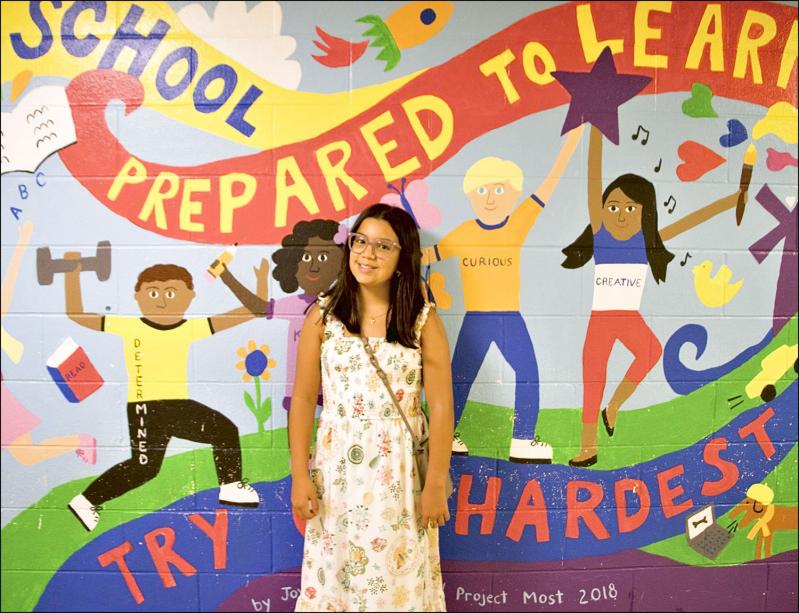In the spring, the first cohort of dual-language enrichment program students graduated from the John M. Marshall Elementary School in East Hampton after having spent their entire time at the school being taught in both English and Spanish. They will begin middle school next week.
“You go into these classrooms and you’re not sure who’s the native Spanish speaker and who’s the new-language learner, and vice versa,” said Stephanie Dubois-Rivera, director of English as a new language and bilingual programs for the East Hampton School District. “They’re flowing between languages speaking about fifth and sixth-grade literature like it’s something they’ve always done.”
Launched in September 2019 to strong support from both English and Spanish-speaking parents, the dual-language program aims to provide native English and native Spanish speakers a path toward bilingualism and biliteracy. Students who opt in to the program follow a typical core curriculum — science, math, language arts — but attend English and Spanish-speaking classrooms on alternating days. The program includes a nearly even ratio of native Spanish to English-speaking students, and most Spanish instruction is by native speakers.
One of these students is Sara Marulanda, who immigrated to East Hampton from Colombia at 8 years old and is set to start middle school. When Sara enrolled in second grade at John Marshall, she knew very little English. “I could say ‘hi,’ ‘hello,’ ‘thanks,’ ‘good’... and ‘pink.’ “ But her homeroom teacher was Alba Pettas, also from Colombia, and Sara acclimated quickly. “It felt like there was a part of where I’m from here, because I had Spanish-speaking teachers like Mrs. Pettas,” said Sara, who estimates that it took her about six months to get comfortable speaking English. Three years later, her facility with the language is indistinguishable from a native speaker’s.
While John Marshall still offers traditional English language learner (E.L.L.) programming, research finds that dual-language students master the language faster than their peers in remedial programming. “We noticed that in our own students,” said the school’s principal, Karen Kuneth. Rather than teaching English using English, as is standard in E.L.L., dual language students learn both English and Spanish from native perspectives. “When you support the first language, a lot of those skills transfer over to the second language,” said Ms. Dubois-Rivera. “Students can use those skills in either language.”
In other academic subjects, the dual-language kids “do just as well as” as students receiving instruction in only one language, said Ms. Kuneth. Further, “research shows that dual-language students outperform their mono-language peers over time.” While significant for both Spanish and English learners, this observation could represent a serious academic leap for students who would otherwise be placed in E.L.L. programs.
Data from the 2023-24 school year shows, for example, that only 27 percent of E.L.L. students achieved proficiency on their English language arts Regents exams, as opposed to the 93-percent proficiency rate of non-English-language learners. On the algebra, living environment, and earth science Regents exams, the E.L.L. rate of proficiency was less than half that of non-E.L.L. students.
There were nearly equal rates of proficiency on the algebra II and geometry Regents. Seventeen percent of E.L.L. students had dropped out of high school before graduation, as opposed to the 2-percent dropout rate for non-English language learners.
For Sara and her family, the benefits of dual-language learning extend beyond academic success. “My mom didn’t want me to lose Spanish or to lose a part of myself,” said Sara. “Because my grandpa and grandma and aunts and uncles don’t speak English, I mostly talk with them in Spanish,” she said. And besides, she said, “Spanish is my native language, and I love it — I love how we Colombians speak, I love the accent . . . I love everything about my language.”
Ms. Dubois-Rivera hears this sentiment often from Latino parents. “The idea that they can send their child off to school knowing they can maintain their Spanish and speak to their families and relatives — that’s important to them. It’s important to us too.”
And for English-speaking parents, the program represents a door into an increasingly multicultural reality. “Given the Spanish-speaking population here and in the number of countries in the world, the opportunity is invaluable,” said Amanda Star Frazier, the mother of a dual-language student entering fifth grade. “The more people you can communicate with the better — both here and abroad.”
Students will have the opportunity to remain in the program in sixth grade at the middle school, in a less immersive format. A bilingually certified teacher from John Marshall will follow the cohort to the middle school to teach language arts, and students will take an advanced Spanish grammar class five days a week. The rest of the day the students will follow a typical middle school schedule. After that, Ms. Kuneth said, “there is a plan to continue in seventh grade. We are still working on the details of that plan.”

